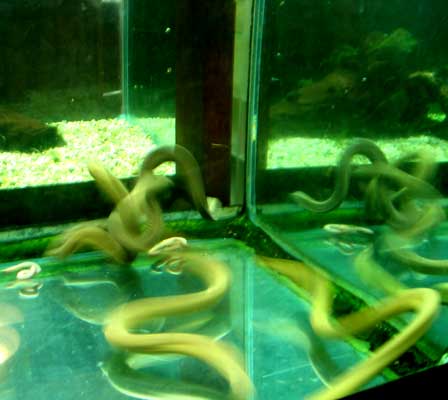Caecilians are legless, burrowing amphibians which mostly live in leaf litter, loose soil, under rocks and decaying logs. They are also found in agricultural fields and only surface during the monsoon. The body is elongated and smooth with a slimy skin. The smaller caecilians superficially resemble earthworms while the larger ones are often mistaken for snakes. However, they can be told apart from earthworms by the presence of eyes, teeth and skeleton and from snakes by the lack of scales on skin. The eyes in caecilians are not well developed which is most likely to be because of their burrowing life style. They are considered as rare which is apparently due to their subterranean habits. To see them one has to search carefully (usually by digging) and be at the right place and at the right time. There are few places where they are common, but, at least one species was reported to be abundant in agricultural fields in Kerala. The larger caecilians look like snakes but their skin is smooth and not scaly.
 caecilians picture
caecilians picture caecilians picture
caecilians picture caecilians picture
caecilians pictureThe Western Ghats Caecilians
The Western Ghats of India are one of the global biodiversity hotspots, and a centre of caecilian diversity. Of the 26 described species of Caecilians from India, 25 are endemic. From distributional records it is apparent that the hot spot of known caecilian diversity in India is the Western Ghats. Of the 20 currently recognized Western Ghats species, most are known from the southern part of the range, including seven species endemic to this area.
As far as is known, all Indian Caecilians are oviparous i.e. they lay eggs and have a free-living, aquatic larval stage. The smallest Indian caecilian is about 142 mm (5.6 in) in length (Gegeneophis krishni) and the longest is 545 mm (21.5 in) (Ichthyophis malabarensis). As per the available information, most caecilians are opportunistic feeders and feed on earthworms, termites, larvae and pupae of a variety of insects. The observation of the faeces of captive caecilians indicates that they may be detritivores i.e. feeding on dead and decomposed organic matter also.
Despite more than 100 years of research in the region, the number of recognised Caecilian species in the Western Ghats is still increasing rapidly. Most of Western Ghats caecilians were previously described from the southern part of the peninsula. However, moderate recent effort expended in the herpetologically under explored northern region has uncovered several new species. The current picture of caecilian biology in the northern Western Ghats is well illustrated by recent discoveries. In the last 18 months, five new species have been described from northern Karnataka and Maharashtra. Thus, we know almost nothing of their biology and they are all of data deficient as a conservation status.
As per the recent reports about 31% of the amphibians of the world are on the verge of extinction. This is really an alarming situation. Many more species are yet to be discovered and if the situation remains the same then they will extinct without our knowledge. These amphibians play a dual role in the food chain. They are predators which keep a check on the insect population and are also prey for a variety of other predators. Their decline is surely going to disturb the balance of the entire food chain which will ultimately affect human beings.
 caecilians picture
caecilians picture caecilians picture
caecilians picture caecilians picture
caecilians picture.jpg) caecilians picture
caecilians picture caecilians picture
caecilians picture
No comments:
Post a Comment